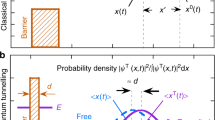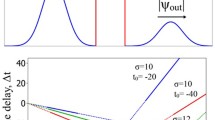Abstract
Fifty years ago Hartman studied the barrier transmission time of wave packets (J Appl Phys 33:3427–3433, 1962). He was inspired by the tunneling experiments across thin insulating layers at that time. For opaque barriers he calculated faster than light propagation and a transmission time independent of barrier length, which is called the Hartman effect. A faster than light (FTL or superluminal) wave packet velocity was deduced in analog tunneling experiments with microwaves and with infrared light thirty years later. Recently, the conjectured zero time of electron tunneling was claimed to have been observed in ionizing helium inside the barrier. The calculated and measured short tunneling time arises at the barrier front. This tunneling time was found to be universal for elastic fields as well as for electromagnetic fields. Remarkable is that the delay time is the same for the reflected and the transmitted waves in the case of symmetric barriers. Several theoretical physicists predicted this strange nature of the tunneling process. However, even with this background many members of the physics community do not accept a FTL signal velocity interpretation of the experimental tunneling results. Instead a luminal front velocity was calculated to explain the FTL experimental results frequently. However, Brillouin stated in his book on wave propagation and group velocity that the front velocity is given by the group velocity of wave packets in the case of physical signals, which have only finite frequency bandwidths. Some studies assumed barriers to be cavities and the observed tunneling time does represent the cavity lifetime. We are going to discus these continuing misleading interpretations, which are found in journals and in textbooks till today.





Similar content being viewed by others
References
Boyd, R.W., Guthier, D.J.: Controlling the velocity of light pulses. Science 326, 1074 (2009)
Nimtz, G.: Tunneling confronts special relativity. Found. Phys. 41, 1193–1199 (2011)
Longhi, S., Marano, M., Laporta, P., Belmonte, M.: Superluminal optical pulse Propagation at1.5 \(\mu \)m in periodic fiber Bragg gratings. Phys. Rev. E 64, 055602(R)(4) (2001)
Winful, H.G.: Energy storage in superluminal barrier tunneling: origin of the Hartman. Effect. Opt. Express 10, 1491–1496 (2002)
Winful, H.G.: Group delay, stored energy, and the tunneling of evanescent electromagnetic waves. Phys. Rev. E 68(1), 016615 (2003)
Winful, H.G.: Nature of superluminal barrier tunneling. Phys. Rev. Lett. 90(2), 023901 (2003)
Winful, H.G.: Delay time and the Hartman effect. Phys. Rev. Lett. 91, 260401 (2003)
Winful, H.G.: Mechanism for superluminal tunneling. Nature 424, 638–639 (2003)
Winful, H.G.: Apparent superluminality and the generalized Hartman effect in double-barrier tunneling. Phys. Rev. E 72, 046608 (2005)
Winful, H.G.: Tunneling time, the Hartman effect, and superluminality: a proposed resolution of an old paradox. Phys. Rep. 436, 1–69 (2006)
Yao, H.Y., Chen, N.C., Chang, T.H., Winful, H.G.: Frequency-dependent cavity lifetime and apparent superluminality in Fabry–Perot-like interferometers. Phys. Rev. A 86, 053832 (2012)
Hartman, T.E.: Tunneling of a Wave Packet. J. Appl. Phys. 33, 3427–3433 (1962)
Eckle, P., Pfeiffer, A., Cirelli, C., Staudte, A., Dörner, A., Müller, H., Büttiker, M., Keller, J.: Attosecond ionization and tunneling delay time measurements in helium. Science 322, 1525–1529 (2008)
Yakaboylu, E., Klaiber, M., Bauke, H., Hatsagortsyan, K., Keitel, C.: Relativistic features and time delay of laser-induced tunnel ionization. Phys. Rev. A 88, 063421 (2013)
Nimtz, G.: On virtual phonons, photons, and electrons. Found. Phys. 39, 1346 (2009)
Brillouin, L.: Wave Propagation in Periodic Structures, 2nd edn. Dover Publications, New York (1953)
Brillouin, L.: Wave Propagation and Group Velocity. Academic Press, New York (1960)
Harris, F.J.: On the use of windows for harmonic analysis with the discrete fourier transform. Proc. IEEE. 66, 51–84 (1978)
Hund, F.: Zur Deutung von Molekülspektren III. Z. Physik 43, 805–826 (1927)
Sommerfeld, A.: Vorlesungen über Theoretische Physik, vol. VI. Dieterich’sche Verlagsbuchhandlung, Berlin (1950)
Kapuscik, E., Henryk Niewodniczanski Institute of Nuclear Physics, Krakow; Mielke, E, Universidad Autonoma Metropolitana-Iztapalapa, Mexico. Private communications.
de Carvalho, C.A.A., Nussenzveig, H.M.: Time delay. Phys. Rep. 364, 83174 (2002)
McColl, L.A.: Note on transmission and reflection of wave packets by potential barriers. Phys. Rev. 40, 621–626 (1932)
Franz, W.: Duration of the tunneling single process. Phys. Status Solidi 22, K139–K140 (1967)
Fletcher, J.R.: Time delay in tunneling through a potential barrier. J. Phys. C 18, L55 (1985)
Collins, S., Lowe, D., Barker, J.E.: The quantum mechanical tunneling time problem—revisited. J. Phys. C 20, 6213–6232 (1987)
Low, F., Mende, P.: A note on the tunneling time problem. Ann. Phys. 210, 380–387 (1991)
Wang, Z.-Y., Xiong, C.-D.: heoretical evidence for the superluminality of evanescent modes. Phys. Rev. A 75(4), 042105 (2007)
Chiao, R.Y., Steinberg, A.M.: Tunneling times and superluminality, pp. 345–405. Progress in Optics, XXXVII (1997)
Steinberg, A. M.: How much time does a tunneling particle spend in the barrier region? Phys. Rev. Lett. 74, 2405–2408 (1995)
Sexl, R.U., Urbantke, H.K.: Relativity, Groups. Particles. Springer, Wien (2001)
Fayngold, M.: Special Relativity and Motions Faster than Light. Wiley, Weinheim (2002)
Chiao, R. Y., Kwiat, P. G., Steinberg A. M.: Faster than light? Scientific American, August, pp. 38–46 (1993)
Haibel, A., Nimtz, G.: Universal relationship of time and frequency in photonic tunneling. Ann. Phys. (Leipzig) 10, 707–712 (2001)
Esposito, S.: Universal photonic tunneling time. Phys. Rev. E 64(8), 026609 (2001)
Olkhovsky, V., Recami, E.: Recent developements in the time anlysis of tunneling processes. Phys. Rep. 214, 339 (1992)
Olkhovsky, V., Recami, E., Jakiel, J.: Unified time analysis of photon and particle tunneling. Phys. Rep. 398, 133 (2004)
Recami, E.: Superluminal tunneling through successive barriers: does QM predict infinite group-velocities? J. Mod. Opt. 51, 913 (2004)
Barbero, A., Hernandez-Figueroa, H., Recami, E.: Propagation speed of evanescent modes. Phys. Rev. E. 62, 8628 (2000)
Aharanov, Y., Erez, N., Reznik, B.: Superoscillations and tunneling times. Phys. Rev. A 65, 052124–1 (2002)
Merzbacher, E.: Quantum Mechanics. Wiley, New York (1970)
Twareque Ali, S.: Evanescent waves in quantum elecgrodynamics. Phys. Rev. D 7, 1668–1673 (1073)
Carniglia, C.K., Mandel, L.: Quantization of evanescent modes. Phys. Rev. D 3, 280–291 (1971)
Nimtz, G.: Do evanescent modes volate causality? Lect. Notes Phys. 702, 506–531 (2006)
Steinberg, A.M., Kwiat, P.G., Chiao, R.Y.: Measurement of the single-photon tunneling time. Phys. Rev. Lett. 71, 708–711 (1993)
Nimtz, G., Heitmann, W.: Superluminal photonic tunneling and quantum electronics. Prog. Quantum Electron. 21, 81–108 (1997)
Anderson, M.: Light seems to defy its own speed limit. New Scientist, 16. August (2007)
Spielmann, Ch., Szipöcs, R., Stingl, A., Krausz, F.: Tunneling of optical pulses through photonic band gaps. Phys. Rev. Lett. 73, 2308 (1994)
Enders, A., Nimtz, G.: Evanescent-mode propagation and quantum tunneling. Phys. Rev. E 48, 632 (1993)
Longhi, S., Laporta, A., Belmonte, M., Recami, E.: Measurement of superluminal optical tunneling times in double-barrier photonic band gaps. Phys. Rev. E 65, 046610 (2002)
Aichmann, H., Nimtz, G., Spieker, H.: Photonische Tunnelzeiten. Verhandlungen der Deutschen Physikalischen Gesellschaft 7, 1258 (1995)
Vetter, R.-M.: Simulationen von Tunnelstrukturen. http://kups.ub.uni-koeln.de/910/
Nimtz, G.: On superluminal tunneling. Progr. Quantum Electron. 27, 417 (2003)
Goos, F., Hänchen, H.: Ein neuer und fundamentaler Versuch zur Totalreflexion. Annalen Physik 6, 333 (1947)
Haibel, A., Nimtz, G., Stahlhofen, A.A.: Frustrated total reflection: The double-prism revisited. Phys. Rev. E 61, 047601 (2003)
Feynman, R.P.: Quantum Electrodynamics. W A Benjamin, Reading (1961)
Gehring, G.M., Liapis, A.C., Lukishova, S.G., Boyd, R.W.: Time-domain measurements of reflection delay in frustrated total internal reflection. Phys. Rev. Lett. 111, 030404 (2013)
Gruschinski, Nimtz, G., Stahlhofen, A.: Resonance-like Goos-Hänchen shift induced by nano-metal films. Ann. Phys. (Berlin) 17, 917–921 (2008)
Shannon, C.E.: A mathematical theory of communication. Bell Sys. Tech. J. 27, 379 and 623 (1948)
Author information
Authors and Affiliations
Corresponding author
Rights and permissions
About this article
Cite this article
Aichmann, H., Nimtz, G. On the Traversal Time of Barriers. Found Phys 44, 678–688 (2014). https://doi.org/10.1007/s10701-014-9804-2
Received:
Accepted:
Published:
Issue Date:
DOI: https://doi.org/10.1007/s10701-014-9804-2
Keywords
- Faster than light velocity
- Front velocity
- Universal tunneling time
- Special theory of relativity
- Einstein causality
- Sommerfeld–Brillouin velocity analysis




